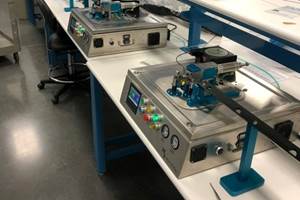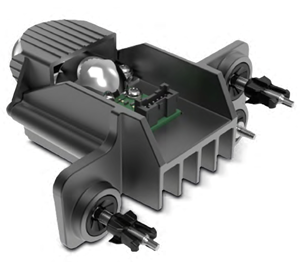Micromolding Sizing Up the Challenges
Molding multiple parts from one pellet's worth of plastic is a challenge that growing numbers of molders want to tackle. It is driving development of new technology in injection machines, tooling, parts handling, and inspection.
Injection molding of parts weighing a fraction of a gram is becoming a sizeable opportunity for molders who serve the electronics, medical, telecommunications, and automotive market sectors. New applications are pushing the limit of what is moldable down to mere dust specks—parts as light as 0.0003 g, walls as thin as 0.0004 in., and dimensional tolerances to ±0.0005 in. All this is being accomplished with CpK's of 1.3 or better, which translates into no more than six defects per 100,000 parts.
Some of the new poppy-seed-sized parts being molded today include gears and gear housings, hearing aids, molded interconnect devices (MIDs), bobbins, switches, sensors, lenses, catheters, gaskets, rollers, and fiber-optic components. These minute parts have even tinier critical features, such as pinholes, pins, channels, and snap-fit latches. Some of these parts involve inserts or two-component molding. "We've delivered a number of systems for parts of this type," says Gregor Goebel, general manager for small injection machines at Battenfeld in Germany. He cites the case of an integrated MID and microswitch for a consumer electronic product. It weighs just milligrams but is made in a two-shot, two-material process.
Micromolding presents a number of challenges to traditional molding concepts. For one thing, molders shouldn't be surprised to see sprue and runner systems amount to 75% or more of the shot. In addition, presses need higher injection speeds and pressures to push melt through tiny nozzles and flow channels. "Normal molding uses about 20,000 psi, while some micromolding applications need up to 40,000 psi, says Glenn Frohring Jr., product manager at Van Dorn Demag. Higher injection speed helps reduce viscosity through shear thinning and ensures that the material will fill the part before it cools. After the parts are molded, handling, inspecting, and packaging present their own set of challenges. (Consider, for example, the need to control drafts and static charges when dealing with flyspeck-sized parts.)
Molding parts like these generally is not recommended on machines larger than 20 tons because it is hard to control such small shot sizes. Also, long residence times and material degradation would occur with oversize (i.e., normal-size) barrels. Lab machines, though small, are not considered good candidates for micromolding, as they are not usually designed for high-volume production. "Process stability is paramount. With a part this small, any variation in the process or material would mean part damage," says Stuart Kaplan, president of Makuta Technics, a molder in Columbus, Ind., whose micro-parts business has tripled in the last 18 months. "Accurate screw and barrel design, and injection control are essential," agrees Herman Plank, managing director of Ferromatik Milacron Europe. "Even when molding a gram of material, you have to be careful not to short-shoot the mold or create flash." For these reasons, machine builders are starting to develop specialized systems for micromolding.
Adding to the challenges, these high-performance miniature parts often require engineering materials like polyamide-imide, liquid-crystal polymer, polyetherimide, PEEK, PPS, and new cyclo-olefin (COC) resins, in addition to more standard ABS, nylon, acetal, and TP polyester. Many jobs also involve fillers like PTFE, Kevlar, carbon fiber, and glass fibers or beads.
Machine designs evolve
As an indication of the growth in this market, 11 machine suppliers in the past two to three years have developed or refined machine designs for micromolding in a tonnage range of about 20 tons and under. They include Arburg, Battenfeld, Boy, Demag Ergotech, Ettlinger, Ferromatik Milacron Europe, Nissei, Sodick, Sumitomo, Tomken Tool, and Van Dorn Demag. Micro-machine sales figures are hard to come by, but one firm reported shipments of 120 units last year. A number of other firms offer small machines that are not specialized for micromolding.
Machinery suppliers are divided on the issue of whether the micromolding market is best served with downsized equipment based on larger conventional designs or whether a new type of machine is required. "With a small conventional machine, sprues must be overdimensioned relative to the part size," says Shawn Schnee, applications and process engineer at Boy Machines. "A sprue that is more than 90% of shot weight is not uncommon when producing micromolded parts on small machines with more traditional screw technology," says Schnee. He adds that cycle times are longer, due to the thicker sprues.
Battenfeld's Goebel adds that a molder using a non-specialized system for micromolding may need more than a year of R&D to find the best way to mold the part, too long for the market life of these new miniaturized components. "There are conventional machines that can produce small parts, but I think they are on the fringes of this market," Goebel says. "And the market is continually asking for smaller parts. I believe the next generation of machines must be capable of making parts 30% smaller and more complex than they can now handle," he says. Tolerances will likely be tighter, as well. "I expect them to shrink from 3 microns today to 1 micron and then to 0.3 micron," Goebel says.
Makers of conventional machines reply that a specialized machine must be a dedicated machine, something that may not suit a lot of custom molders. In addition, molders savvy enough to use a conventional machine may exploit the higher cavitation allowed by a larger press.
Micromolding machine styles encompass plunger, reciprocating-screw, and multi-stage injection technologies. They also span the range of all-electric, hydraulic, and hybrid hydraulic/electric drive systems. Despite these variations, there are three areas of consistency in current approaches:
- Micromolding demands a small screw that is proportioned to the shot size, but there is a limit to how small. "Generally a 14-mm screw is the smallest root diameter you want to use," says Boy's Schnee. "Anything smaller runs the chance of shearing the screw. It can't withstand the pressures during injection," he says. And a smaller-diameter screw can present difficulties in feeding pellets, as well. Some suppliers recommend use of micropellets with micromolding screws.
- Runner systems designed for micromolding tend to be cold-runner types, mainly because hot-runner systems have not been engineered for such small parts.
- As for machine controls, there is consensus that newer 32-bit microprocessors offer the best chance of achieving tight operating control in micromolding.
An integrated solution
A 5-ton, all-electric machine from Battenfeld, dubbed the Microsystem, is one of the first commercial models to be designed specifically for micromolding. Unveiled in October 1999, it is the only model on the market today designed as a complete automated molding cell integrating injection, tooling, part handling, and inspection into one machine with its own clean-room environment. It provides shot weights from 0.25 mg to 1 g and part weights less than 0.008 g.
The unusual three-stage injection system (see schematic) starts with a fixed extruder of 14-mm diam. and 14:1 L/D, tilted at a 45° angle. It continuously feeds a vertical metering chamber. The chamber has a 5-mm diam. plunger that is pushed back as the incoming melt pools in front of it. A pressure sensor detects when the piston's position reaches the preset shot volume. Very precise, servo-driven and pressure-controlled metering gives shot-size control within 0.001 cc, Battenfeld claims.
Next, the pneumatic piston delivers the melt to the injection chamber. The injection plunger, driven by a combination of servo drive and mechanical cam injects melt at a speed of 760 mm/sec.
The melt flows through an internally heated nozzle that protrudes through the fixed platen to the split line of the mold. The rotating mold table with two mold halves permits simultaneous injection and ejection of the previous shot. Molds incorporate interchangeable cavity inserts made with a technology developed in Germany, called LIGA (X-ray lithography and electro-deposition).
Battenfeld says the tiebarless clamp is accurate to within 0.01 mm. A special cavity-centering technology ensures the accuracy of the parts. Ejector pins of just 0.2 mm diam. push out the parts. A side-mounted robot grabs the parts with suction pads and delivers them to the inspection station, which has up to four cameras.
Boy Machines prefers a reciprocating screw to multi-stage injection in order to avoid dead spots where melt can hang up. Boy's micromolding screw has a ball valve in place of the standard check ring. For micromolding, Boy offers its fully hydraulic, two-platen 12 M and 12 A models (14.2 tons). The higher-level Procan CT control on the 12 A is better suited to micromolding, according to the company. The 14-mm, 18:1 reciprocating screw provides shot sizes from under 0.1 g up to 5 g. A 16- or 18-mm screw is also available. Melt is injected at 9.4 in./sec with injection pressures up to 26,034 psi. "We use an amplifier to preload the pumps. We try to oversize the pressure for micromolding applications," says Schnee.
Other features include a vision system for part inspection and a negative-pressure conveyor system to transport parts.
Ferromatik Milacron Europe developed its Micro Injection line of machines to produce parts of 0.001 to 3 g. It features a preplasticating screw set at a 45° angle to an injection plunger. The 18-mm, 15:1 screw accommodates standard-size pellets. It meters melt through a ball check valve to the injection plunger, which comes in three sizes for shot weights of 2.263 to 5.588 g. According to Ferromatik's Plank, the 7-mm-diam. plunger provides four times better stroke resolution than a 14-mm screw, so shot-size accuracy is greater. "The plunger design also provides better peak pressure control, so we achieve lower pressure peaks during transfer," says Plank. The injection-unit design avoids edges or sharp corners to eliminate resin degradation. The unit can be designed for two-component molding.
Among the smallest parts made on that unit is a 0.08-g acetal medical part molded in eight cavities. Total shot weight is 1.6 g.
The MCP Minimolder series, which supersedes the Rabit and Butler range distributed by Tomken Tool and West Coast Mold, is a 9.9-ton machine with two-stage screw/plunger injection. It is designed and manufactured by MCP Equipment in the U.K. It has a 16-mm, 2:1 or 4:1 screw with an injection plunger as small as 7.5 mm diam. Says Tomken sales manager Kevin Undem, "We have molded parts down to 0.02 g in a wide range of engineering thermoplastics such as PEEK and PPS. We have achieved extremely accurate dosing and minimal material residence time using sophisticated transducers on the injection stroke." He says a recent 2-hr production run achieved dimensional accuracy of 0.0001 in. and repeatability of 0.23%.
The TR20EH is a new 20-ton electric hybrid machine for micromolding from Sodick. It molds shot sizes down to 0.2 g using a 14-mm-diam. plunger. The plunger has 5-mm travel, of which the last 1.0-1.5 mm provides packing pressure. Injection speed can reach 1500 mm/sec, says Taekkyu Lee, regional sales manager. The unusual clamp uses a servo motor for opening and closing and a small amount of oil for clamping (see PT, Feb. '00, p. 11). The two-stage injection unit uses an uptilted, servo-driven extruder and a hydraulic plunger.
A tiebarless, in-line screw/plunger system capable of producing 0.1-g to 5-g parts comes from Ettlinger in Germany. The Direct-Injection Molding (D-I-M) machine has the plasticating cylinder and the plunger joined into one reciprocating unit. A patented needle shutoff nozzle in front of the screw forms an integral part of the hot-runner system (PT, Jan. '00, p. 41). The hot runner—rare in micromolding today—and nozzle make it possible to produce virtually sprueless parts. Other benefits are said to include reduced pressure loss, short material dwell times, and low tooling costs.
Molding of electronic and other precision parts can be accomplished with new 45-ton and 66-ton hydraulic-clamp models in the PN Series from Nissei America. The units replace similar tonnage machines from Nissei's long-selling PS Series and feature a number of machine improvements (see p. 13 of this issue). Nissei also offers three 7-ton models in its HM line of ultra-compact units for micro-part production.
Sumitomo recently extended its standard line of all-electric machines with a 20-ton model, the SE18S. The unit handles screw diameters down to 14 mm and injection capacities down to 0.38 cu in. A beltless direct-drive motor provides 500-mm/sec injection velocity and injection pressures up to 34,130 psi. Other standard features include digital setting of the mold open/close position to within 0.1 mm and low-pressure mold protection to 0.3 mm, a feature important for micromolding, say company sources.
Meiki America offers a 50-ton accumulator-equipped machine for high-volume production of micro parts weighing as little as 0.1 g and having walls as thin as 0.3 mm. "Our M50C-AS-DM unit can mold 20 1-g parts using standard clamping tonnage and cavity pressure," says assistant manager Henry Chang.
The firm's 70-ton unit has been used to make electronic connectors with part weights less than 1 g. This high-speed, high-pressure hydraulic unit produced pairs of 0.3-mm boxes of ABS/PC in 7-8 sec. Features of the bigger press include an accumulator-assisted, servo-valve injection unit, a special long nozzle, and sensitive control of nozzle temperature—an important feature for precision molding of small parts, says Chang. Six-stage clamping pressure reportedly allows enhanced venting from the parting lines during fast fills.
Parts as small as 0.1 g can be produced on the Microshot 25-ton reciprocating-screw machine from Demag Ergotech. This hydraulic-clamp model includes a new screw and barrel design (14 mm, 18:1 L/D), a new check ring, and 0.5-oz maximum shot size. It provides injection speeds of 10-12 in./sec and injection pressures to 30,000 psi. Clamp force can be adjusted down to 5 tons for small-parts molding. An ultrasonic sensor provides 0.0001-in. clamp-position accuracy, says Rick Schaffer, v.p. of sales and marketing at Demag Ergotech.
Arburg sources say the firm's new Allrounder 220 S fully hydraulic 17-ton machine is being used successfully in micromolding. An optional package includes a newly developed screw and barrel of 15 mm diam. that generates up to 36,250 psi. It reportedly can control a screw stroke of just 3 mm to provide exact shot weights down to 0.5 cc (50 mg). The micromolding package also includes a servo valve and screw-position control for fast response and accurate metering and backpressure, both of which are critical to micromolding, according to Arburg.
Van Dorn Demag serves the micromolding market with its new 28-ton Cadence horizontal hydraulic machine and its 30-ton Newbury vertical toggle unit. Both machines have 0.5-oz shot capacity using a 14-mm, 20:1 screw. Injection pressure for the horizontal Cadence press is 20,000 psi standard, or nearly 40,000 psi with an optional performance package. The vertical unit has 30,000-psi standard pressure capability.
‘Micro' pioneers
Even though micromolding is relatively new, a few U.S. molders have been entrenched in that field for years. One of these is Micromold Inc. in Riverside, Calif., a micromolder since 1979. The $5-million/yr firm molds some 75 million parts annually, usually no bigger than 0.375 in. It molds them to tolerances of ±0.0005 in. with CpKs of 1.3 or better. It has 28 presses from 4 to 34 tons, most of them from Boy.
Micromold has learned that one of the secrets to holding part dimensions within 0.0002 in. is to use tools with low cavitation, even when the job calls for millions of parts. "Other firms failed because they went with larger cavitation tools," says president Robert Aust. Careful parts handling, special part-transport fixtures, and a multi-step QC process are other keys to the firm's success. (See PT, May '00, p. 35 for more details.)
"Lights-out" micromolding is one aspect of precision micro-part molder Makuta Technics, Columbus, Ind., which produces 45 million parts yearly with zero defects, says president Stuart Kaplan. This three-shift/seven-day operation runs unmanned on weekdays after 4:00 p.m. and on weekends. Makuta's 17 Sumitomo machines of 15-18 tons (including a new SE18S all-electric unit and six two-shot Minimat models) can run unattended because of automated parts-handling devices designed by the firm's 24 employees. One of their inventions is a venturi system designed to gently separate 5-10 micron gates and the runner from micro parts. Another is a bagging carousel that indexes automatically at preset intervals to prevent containers from overflowing with parts.
Makuta maintains a tightly controlled process window and uses frequent mold maintenance to keep total scrap at less than 1%. One of its prize parts is an acetal coil bobbin that measures 1.11 x 0.96 x 0.64 mm and weighs 0.3 mg. It's produced in a two-cavity mold with a 4.8-sec cycle.
More than 25% of the jobs produced by Empire Precision Plastics, a QS 9000-certified custom molder in Rochester, N.Y., weigh less than a gram. "We have more than 400 parts in production and manufacture more than 250 million parts a year. Our smallest part weighs 0.0052 g and runs in an eight-cavity mold," says Neal Elli, president. The firm believes in large cavitation and uses machines of 25, 35, and 50 tons from Arburg, Sumitomo, and Van Dorn Demag.
Approximately 10% of Empire's projects use 16- to 32-cavity tools, 60% are eight-cavity molds, 20% have four cavities, and the final 10% are just two cavities. All of them use a common mold base and interchangeable cavity inserts. Even with so many cavities, Empire holds tolerances of ±0.001 in.
Three-year-old Micro Molding Technologies LLC in Boynton Beach, Fla., swears by cavity-pressure control to protect delicate mold cores for its micro parts. One of its smallest parts is a 0.03-g connector that the customer switched from another molder. "The previous molder was having trouble maintaining part quality and couldn't figure out why," says president Michael Bentz. The unsuccessful molder had tried monitoring the mold with a vision system to detect what was going on. When Micro Molding Technologies got the job, it used cavity-pressure sensing to determine that a cold slug of material would come through the nozzle at high speed and pressure, damaging the delicate core pins. "This allowed us to find the root cause of the problem instead of running bad parts while searching for an answer." Bentz says. The firm uses a cavity-pressure controller from RJG Inc. on all of its jobs.
Related Content
Innovative Micro-Molding From Minnesota Machine Shop
Machine shops are natural inventors, but not necessarily suited to supporting and marketing a product. This Minnesota shop with an invention related to micromolding will share it through licensing.
Read MoreX2F and Covestro Collaborate on Innovative In-Mold Electronics for Automotive Lighting
Thermally conductive PC heat-sinks produced with X2F controlled viscosity molding.
Read MoreMidtonnage Hybrid Range With Compact Footprint Launches
NPE2024: Milacron has the global launch of its new M-Series injection molding machine line featuring a large clamp stroke as standard in a line of midtonnage, compact-footprint machines.
Read MoreSlimmer All-Electric Press Debuts
A slimmed-down version of Engel’s all-electric, e-mac injection molding machine is among eight displays, which also include LSR micromolding, quick mold changes and a cube mold.
Read MoreRead Next
Processor Turns to AI to Help Keep Machines Humming
At captive processor McConkey, a new generation of artificial intelligence models, highlighted by ChatGPT, is helping it wade through the shortage of skilled labor and keep its production lines churning out good parts.
Read MoreAdvanced Recycling: Beyond Pyrolysis
Consumer-product brand owners increasingly see advanced chemical recycling as a necessary complement to mechanical recycling if they are to meet ambitious goals for a circular economy in the next decade. Dozens of technology providers are developing new technologies to overcome the limitations of existing pyrolysis methods and to commercialize various alternative approaches to chemical recycling of plastics.
Read MoreHow Polymer Melts in Single-Screw Extruders
Understanding how polymer melts in a single-screw extruder could help you optimize your screw design to eliminate defect-causing solid polymer fragments.
Read More



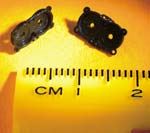
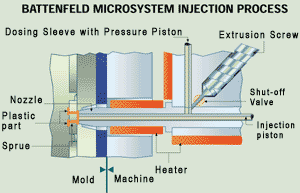



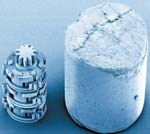

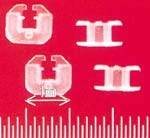











(1).png;maxWidth=300;quality=90)


.png;maxWidth=300;quality=90)




